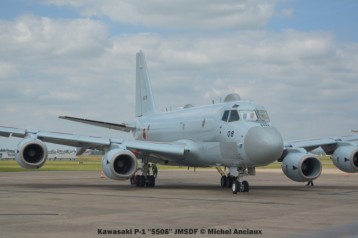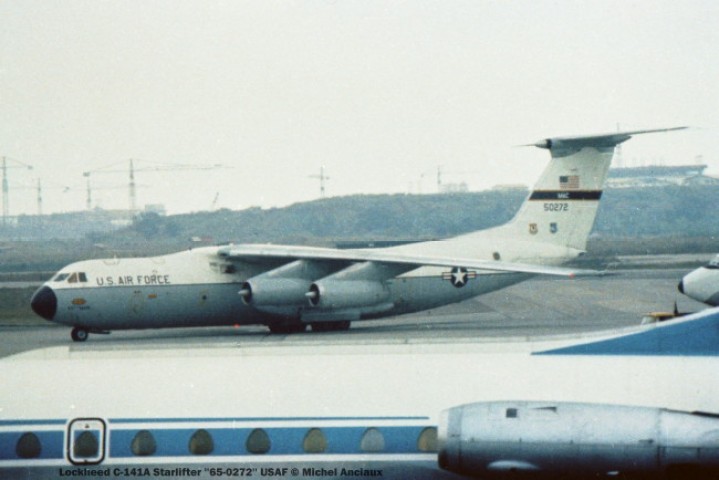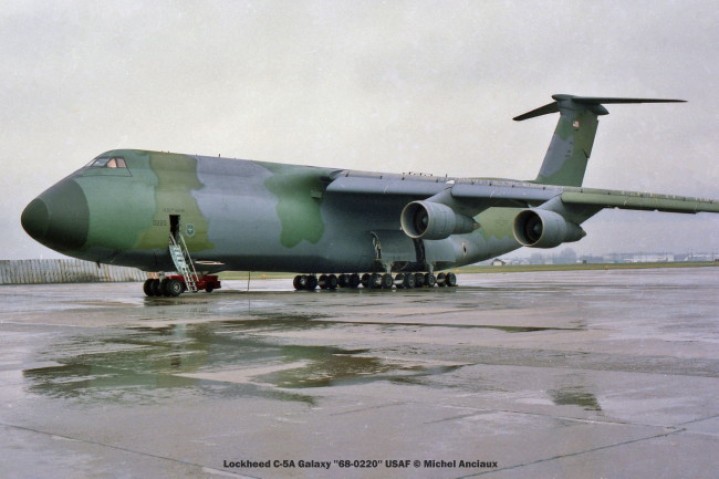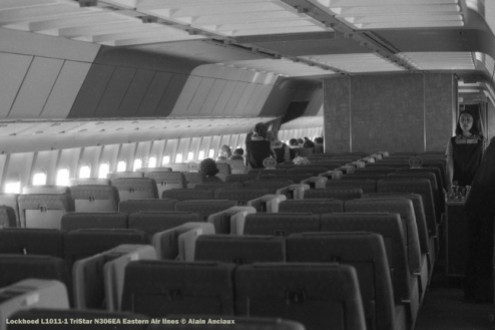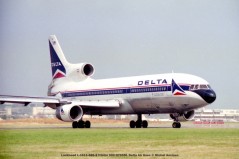translation in english available at the bottom.
Lockheed P-3 Orion
Mitad de los años 1957 la Marina de los Estados Unido vio la necesidad de reemplazar sus Lockheed P2V Neptune e hidroaviones Martin P5M Marlin con equipos más modernos.
Igual el Neptune siguió en operación hasta 1978 y los P5M Marlin continuaron sus labores hasta 1965, en el conflicto de Vietnam entre otras. El último Marlin de la Marina de los EE.UU fue almacenado en la base aeronaval de Patuxent River el 12 de julio 1968.
Es así que la Lockheed presentó un proyecto derivado de su L-188 Electra, diseño que es aceptado en abril de 1958 como avión de patrulla y reconocimiento marítimo, búsqueda y salvamiento (SAR) y sobre todo lucha anti submarina.
El prototipo número 3 del Electra con matricula N1883 sirvió como base para el primero P-3 Orion y voló por primera vez en su nueva configuración YP3V-1 el 25 de noviembre, 1959.
(Un dato mencionando el 19 de agosto, 1958 es en realidad la fecha de su primer vuelo como L-188 Electra).
Comparando con su versión civil, el fuselaje del Orion es más corto de 2,24 y esta equipado con una bodega de bombas.
También estaciones subalares tipo pod permite llevar misiles navales aire-superficie y un detector de anomalía magnética está almacenado en su cola bien característica.
Sus primeras operaciones fueron en la crisis de los misiles cubanos, participando en el bloqueo de las rutas marítimas hacia la isla.
A partir de 1964 participaron en la guerra de Vietnam. La lista de operaciones y conflictos en las cuales participaron los Orion no solo de la US Navy pero también de Australia, Canadá, España, Portugal es larga y es solo de mencionar las en Kuwait, Afganistán, Somalía para la lucha contra la piratería marítima y Somalía.
El P-3 viene en versiones distintas permitiendo misiones correspondientes.
Con los años y el retiro de ciertas cantidades de Orion, unos P-3 han sido convertidos para el mercado civil, principalmente en la lucha de incendios.
734 ejemplares fueron construidos y el Boeing P-8 A Poseidon, una versión del Boeing 737-800ERX es el nuevo integrante del inventario US Navy, proyectado como remplazando del venerable P-3 Orion.
Japón también quiere posicionarse en el mercado internacional promoviendo el Kawasaki P-1 y su presencia tanto en la feria internacional de Le Bourget 2017 como en Farnborough 2018 demuestra bien las intenciones del constructor japonés.
Lockheed L-1329 Jetstar
El L-1329 Jetstar o C-140 en su identificación militar es un jet ejecutivo propulsado por 4 reactores Pratt & Whitney JT12 y se caracteriza por sus estanques Zapatilla en las alas con capacidad de 4,000 libras (1,814.3 litros) más un contenido de 10,000 libras (4,535.9 litros9) en las alas permitiendo un alcance de 2,995 mi o 4,820 km.
Al contrario de los aviones existentes, la característica principal del Jetstar está en sus compensadores horizontales que se pueden ajustar girando todo el conjunto de cola y estabilizadores horizontales. Por eso se nota una zona distintiva sin pintar en la base de la cola.
El Lockheed Jetstar es considerado como el segundo avión jet ejecutivo si tomamos en cuenta el Morane Saulnier Paris pero es evidente que las características y diseño de cabina son en ninguna manera comparables.
Los 2 prototipos eran bireactores equipados con motores Bristol Siddeley Orpheus.
El primero efectuando su vuelo de prueba el 4 de septiembre de 1957. En cuanto al segundo, este venía con los estanques de combustible zapatilla en las alas y luego en 1959 los cuatros motores Pratt & Whitney este por no lograr un acuerdo con la empresa motorista inglesa Bristol Siddeley para construir los motores Orpheus en los Estados Unidos.
El modelo propulsado por los motores JT12 entro en servicio en 1961.
La USAF opero dieciséis Jetstar bajo la denominación C-140A para inspección de vuelos, pruebas de sistemas de navegación. También operaron en Vietnam.También once modelos C-140B fueron utilizados como transporte de personal. 6 de los cuales eran VC-140B y solían operar como Air Force One desde la base aérea de Andrews en Washington.
El Jetstar fue uno de los tantos aviones alcanzado por las reglamentaciones sobre el ruido y el aumento progresivo del precio del combustible resulto en el proyecto 731 Jetstar, una versión equipado con los motores turbofan Garrett AirResearch TFE731.
En total fueron 204 aviones producidos entre 1960 y 1978.
Lockheed C-141 Starlifter
En la década de los años 50 el componente MATS (Military Air Transport Service) de La Fuerza Aérea de los Estados Unidos utilizaba aviones con motores de pistones tales los Douglas C-118 Liftmaster y C-124 Globmaster II pero también la versión carguera del Boeing C-97 Stratofreighter, todos con sus límites operacionales.
Luego llegaron los C-130 Hercules y el C-133 Cargomaster pero no eran suficiente para la nueva política americana de “respuesta flexible” es decir responder a una ayuda o ataque en cualquier parte del mundo en el menor tiempo posible.
Es así que a mitad de 1960, la USAF público el requerimiento para un avión con los siguientes rendimientos: una carga útil de 27.200 kg (60 000 libras) y una autonomía de vuelo de 6480 km (4025 millas).
Fue seleccionado el diseño de Lockheed con la denominación C-141 Starlifter y un contrato firmado en marzo de 1961 para 5 prototipos, pero al final solo uno fue construido.
El vuelo de prueba inicial se realizó el 17 de diciembre de 1963.
El Starlifter venía con elementos comparables al C-130 Hercules, es decir puertas de carga y rampa trasera con la capacidad de abrirse en vuelo permitiendo así soltar cargas o paracaidistas. Trenes de aterrizaje principales posicionados en compartimientos por el costado del fuselaje permitiendo así una cabina de carga sin obstrucción. La diferencia está en los motores: cuatros Pratt & Whitney TF33-P-7, la designación militar del reactor JT3D de los Boeing 707 entre otras, en lugares de motores turbohélices, y una cola en T.
El primero C-141 fue entregado el 23 de abril de 1965 y asignado al escuadrón de transporte n°44 en la base de Travis.
284 C-141A fueron construidos y al entrar en servicio operativo fueron utilizados para vuelos a Vietnam.
Progresivamente esta versión fue convertida en la B con alargamiento del fuselaje y para finalizar 64 C-141B fueron modernizados con instrumentación de vuelo y navegación mejorados.
Fue dado de baja en mayo de 2006 y reemplazado con el Boeing C-17 Globmaster III
El C-141A fue el primero Starlifter de la familia construido por la Lockheed, teniendo una capacidad de 138 “pasajeros” o 28 900 Kg de carga pero luego se comprobó que el volumen de la bodega de carga era relativamente escaso comparado con la capacidad de carga del avión.
Por esta razón y para poder utilizar el avión al máximo de sus capacidades, los 270 C-140A ya en servicio fueron convertidos entre 1977 y 1982 en C-141B alargando de 7,11 metros el fuselaje y permitiendo así mayor volumen de carga. Otra adaptación fue la posibilidad de reabastecimiento en vuelo. El espacio disponible correspondía a 3 pallets. Su capacidad era de 205 “pasajeros” (soldados) o 168 paracaidistas.
El Starlifter participó también en operaciones en Haití, Bosnia, Somalía, Rwanda y en 1991 en la guerra del Golfo.
El avión fue dado de baja del AMC (Mobility Air Command, heredero del MATS y MAC) en septiembre de 2004, con la llegada de los Boeing C-17.
Aun 2 escuadrones de la reserva lo utilizaron todavía por 2 años y en 2005, los 8 C-141B aun en servicio operaron en Iraq y Afganistán.
El último vuelo de un Starlifter, es decir un C-141 en su versión C fue el 6 de mayo de 2006 cuando el 66-0177 Hanoi Taxi fue entregado al museo de la Fuerza Aérea de los Estados Unidos. Había servido en la repatriación de prisioneros de guerra de Vietnam en 1973. Por eso el sobrenombre.
Lockheed C-5 Galaxy
En 1963, la Fuerza Aérea de los Estados Unidos llegó a la conclusión de que necesitaba un avión jet capas de suplantar el C-133 Cargomaster turbo hélice y sobre todo con la capacidad de transportar las cargas más pesada y con dimensiones no compatibles para el C-141 recién puesto en servicio, siendo de tal forma un avión complementario al Starlifter utilizado en el ala MATS (Military Air Transport Service).
Es así que en abril de 1963 fue iniciado el proyecto CX-HLS (para Cargo Experimental-Heavy Logistics System es decir Sistema experimental de logística de cargas pesadas).
Las especificaciones y requerimientos eran los siguientes: El avión debe ser capaz de transportar una carga de 56 700 kg (12 500 libras) sobre una distancia de 12 875 Km (8000 millas).
Despegar en una distancia de 2438m (8000 pies) y aterrizar en la mitad de esta distancia.
También debía ser capaz de transportar todo tipo de material, equipos o vehículos significando un avión de mayor dimensión que el C-141.
Cada uno de los grandes constructores aeronáuticos presentó su proyecto a saber Boeing, Douglas y Lockheed y fue esta última quien fue seleccionada, con su diseño de un C-141 ampliado en todas sus dimensiones.
La fabricación del prototipo del nombrado C-5A se inició en agosto de 1966 y al salir de los hangares de construcción de la Lockheed Georgia en Marieta (al sur de Atlanta) el 2 de marzo de 1968 era entonces el avión más grande del mundo, con un peso máximo al despegue de 346 771 kg o 764 500 libras.
Perdió su posición de líder en 1982 debido a la llegada del Antonov 124 ruso con sus 392 toneladas y el Antonov 225 (640 toneladas) en 1988 pero igual es el avión de mayor dimensión en uso en la USAF.
El Galaxy puede llevar 36 paletas tipo 463L o 270 “pasajeros” (73 en el puente superior y 193 en la zona de carga adaptada para transporte de tropas), la zona de carga teniendo una dimensión de 39 metros o 121 pies.
Puede ser reabastecido en vuelo siendo esto un primer para un avión de transporte/carga.
El primer vuelo de prueba se realizó el 30 de junio de 1968.
Sus primeras operaciones fueron por supuesta en la Guerra de Vietnam. Luego fue utilizado también para abastecer Israel en material durante la guerra de Kippour en 1973.
Fue utilizado en grande escala en la guerra del golfo en 1991, así como en Rwanda en 1994 sin olvidar Afganistán e Iraq.
En los años 70, pequeñas grietas aparecieron en las alas de los primeros C-5 construidos necesitando unas restricciones en la carga máxima del C-5A.
77 modelos A del Galaxy recibieron nuevas alas entre 1981 y 1987.
50 C-5 modelos B completaron la flota de los 76 C-5A a partir de 1986. La diferencia siendo en sus alas consolidadas eliminando así el problema encontrado con los C-5 de primera generación. También el puesto de mando fue actualizado con nueva aviónica.
2 C-5 convertidos en modelos C son utilizado en apoyo a los programas de la NASA. La modificación esta en las puertas traseras de cargamento.
El último programa de modificación y mejoramiento del Galaxy resulto en 1998 con el inicio de modernizaciones de 52 C-5 en el modelo M Super Galaxy.
Este programa permite extender las operaciones de los C-5 Galaxy en la USAF hasta los años 2040.
El Super Galaxy viene con nuevas aviónicas en una cabina de mando con 6 pantallas planas, motores General Electric CF6-80C2 más eficientes, los mismo que propulsen los Boeing 747, VC-25 o Air Force One, los 767, McDonnell Douglas MD-11, Airbus A300-600 y el Kawasaki C-2
En total, 131 C-5 Galaxy fueron construidos.
Lockheed L-1011 Tristar
El desarrollo del Tristar es a consecuencia de un pedido formalizado en los años 1965-1966 por American Airlines, que quería un avión de fuselaje ancho pero con capacidad menor que el Boeing 747 ya en desarrollo.
Es de recordar que la empresa Lockheed había tenido un largo historial de aviones civiles, la más conocida siendo la familia de los Constellation pero el L-188 Electra fue el último diseño de aviones comerciales producidos por la Lockheed.
Si el proyecto inicial era un bireactor, fueran las líneas aéreas Eastern y TWA que favorecieron la configuración de 3 motores para más seguridades. En estos años el concepto del birreactor aun no favorecía las líneas aéreas comerciales.
En el mismo tiempo, la Douglas estaba ya finalizando su diseña del trireactor DC-10.
La similitud entre las dos aeronaves se debía a las especificaciones presentadas por las líneas aéreas pero unas diferencias notables están el motor de cola.
Si para el DC-10 el motor está colocado al final de un conducto recto Lockheed opto para una entrada de aire en forma de S y el motor integrado al final del fuselaje.
Fue desarrollado como avión de medio a largo alcance con 3 motores Rolls-Royce RB211, una capacidad de hasta 400 pasajeros y alcance de vuelo de 4,000 millas o 7,410 km.
Al final American opto por el DC-10.
Dos versiones con dimensiones de fuselajes fueron desarrolladas: El L-1011-1 que fue puesto en servicio en 1972 con la Eastern Airlines y el L-1011-500 con un fuselaje más corto que voló por primera vez en 1978, siendo puesto en operaciones comerciales por primera vez con la British Airways. Otras versiones salieron a lo largo de la producción del L-1011 a saber el L-1011-100, el L-1011-200 y el L-1011-300, que tenían un peso máximo al despegue mayor o plantas motores de mayor potencias.
Si inicialmente ninguna versión militar fue desarrollada a partir del Tristar, La Real Fuerza Aérea tenía la necesidad de un avión para sus operaciones. Inicialmente 6 Tristar 500 fueron adquiridos de la British Airways en 1982 y convertidos en tanqueros y transportes de cargas y/o pasajeros.
Al final fueron 2 Tristar que recibieron la conversión K1 es decir solo tanquero y cuatros en la versión KC1 tanquero/carguero.
En 1984, 3 L-1011 más fueron agregados a la flota de tanqueros de la RAF pero estos ex Pan Am no recibieron las conversiones K1 o KC1 recibiendo la designación C2 o C2A.
Participaron en todos los conflictos del Medio Oriente y su retiro del servicio se inició al inicio de 2014, siendo sustituido por el Airbus A330 Voyager.
250 aviones de los distintos modelos disponibles salieron de la planta de Palmdale, el ultimo siendo en 1984.
Michel Anciaux
Fuentes de documentaciones
Wikipedia.org
Armada.cl
Militaryfactory.com
Aviationmilitaires.net
museumofflight.org
pacificcoastairmuseum.org
fas.org
capital.fr
airforce-technology.com
psk.blog.24heures.ch/tag/c-5m+super+galaxy
lockheedmartin.com
aviationcv.com
aeroresource.co.uk
Lockheed P-3 Orion
Half of 1957, the United States Navy saw the need to replace their Lockheed P2V Neptune and amphibious aircraft Martin P5M Marlin with more modern equipment.
The same Neptune continued in operation until 1978 and the P5M Marlin continued its work until 1965, in the Vietnam conflict among others. The last Marlin of the US Navy was stored at the Navy base of Patuxent River on July 12, 1968.
So, Lockheed presented a project derived from its L-188 Electra, a design that was accepted in April 1958 as a patrol and maritime reconnaissance aircraft, search and rescue (SAR) and above all antisubmarine warfare.
The prototype number 3 of the Electra with registration N1883 served as the basis for the first P-3 Orion
It flew for the first time in his new YP3V-1 configuration on November 25, 1959.
(A data mentioning August 19, 1958 is actually the date of his first flight as the L-188 Electra)
Comparing with its civil version, the fuselage of the Orion is 2.24 meters shorter is equipped with a bomb bay.
Also underwings pod stations allow air-surface naval missiles to be carried and a magnetic anomaly detector is stored in its well-characteristic tail
Its first operations were in the crisis of the Cuban missiles, participating in the blockade of the maritime routes to the island.
From 1964, they participated in the Vietnam War. The list of operations and conflicts in which the Orion participated with not only the US Navy but also Australia, Canada, Spain, Portugal is long and it is only to mention those in Kuwait, Afghanistan, Somalia this last for the fight against maritime piracy.
The P-3 comes in different versions allowing corresponding missions.
Over the years and the withdrawal of certain quantities of Orion, some P-3 have been converted for the civilian market, mainly in firefighting.
734 copies were built and the Boeing P-8 A Poseidon, a version of the Boeing 737-800ERX is the new member of the US Navy inventory, projected as a replacement to the venerable P-8 Orion.
Japan also wants to position itself in the international market by promoting the Kawasaki P-1 and its presence in both the international fair of Le Bourget 2017 and Farnborough 2018 well demonstrates the intentions of the Japanese builder.
Lockheed L-1329 Jetstar
The L-1329 Jetstar or C-140 in its military identification is an executive jet powered by 4 Pratt & Whitney JT12 jet engines and is characterized by its slipper tanks on the wings with capacity of 4,000 pounds (1,814.3 litres) plus a content of 10,000 pounds (4,535.9 litres) in the wings allowing a range of 2,995 mi or 4,820 km.
Unlike the existing airplanes, the main characteristic of the Jetstar is in its horizontal stabilizers that can be adjusted by turning the entire set of horizontal stabilizers and vertical tail. That is why a distinctive unpainted area is noted at the base of the tail.
The Lockheed Jetstar is considered as the second executive jet plane if we take into account the Morane Saulnier Paris but it is clear that the characteristics and design of the cabin are in no way comparable.
The two prototypes were twinjet engines equipped with Bristol Siddeley Orpheus engines.
The first one carrying out his test flight on September 4, 1957. As for the second one, it came with the slipper fuel tanks on the wings and then in 1959 the four Pratt & Whitney engines as Lockheed was not able to reach an agreement with the english Bristol Siddeley motor company to build Orpheus engines in the United States.
The model powered by the JT12 engines came into service in 1961.
The USAF operated sixteen Jetstar under the denomination C-140A for flight inspection, navigation system tests. They also operated in Vietnam.
Also eleven C-140B models were used as personnel transport. Six of which were VC-140B and used to operate as Air Force One from Andrews Air Base in Washington.
The Jetstar was one of the many airplanes touch by the noise regulations and the progressive increase of the price of the fuel resulted in the project 731 Jetstar, a version equipped with the turbofan engines Garrett AirResearch TFE731.
In total there were 204 aircraft produced between 1960 and 1978.
Lockheed C-141 Starlifter
In the decade of the 50s, the MATS component (Military Air Transport Service) of the US Air Force used airplanes with piston engines such as the Douglas C-118 Liftmaster and C-124 Globmaster II but also the cargo version of the Boeing C-97 Stratofreighter, all with their operational limits.
Then came the C-130 Hercules and the C-133 Cargomaster but they were not enough for the new American policy of «flexible response», that is to respond to an aid or attack anywhere in the world in the shortest possible time.
Thus, in the middle of 1960, the USAF issued a request for an airplane with the following performances: a useful load of 27,200 kg (60,000 pounds) and a flight range of 6480 km (4025 miles).
The design of Lockheed was selected with the denomination C-141 Starlifter and a contract signed in March 1961 for 5 prototypes, but in the end, only one was built.
The initial test flight was performed on December 17, 1963.
The Starlifter came with elements comparable to the C-130 Hercules, i.e. cargo doors and rear ramp with the ability to open in flight thus allowing dropping of cargo loads or paratroopers.
Main landing gears positioned in compartments along the side of the fuselage thus allowing a cargo cabin without obstruction. The difference is in the engines: four Pratt & Whitney TF33-P-7, the military designation of the JT3Djet engine of the Boeing 707 among others, in places of turbohélices engines, and a T tail.
The first C-141 was delivered on April 23, 1965 and assigned to transport squadron No. 44 at Travis Air Force base.
284 C-141A were built and when entering operational service they were used for flights to Vietnam.
Progressively this version was converted into the B one,with lengthening of the fuselage and to finish 64 C-141B were modernized with improved flight and navigation instrumentation.
It was decommissioned in May 2006 and replaced with the Boeing C-17 Globmaster III
The C-141A was the first Starlifter of the family built by the Lockheed having a capacity of 138 «passengers» or 28,900 kg of cargo but then it was found that the volume of the cargo hold was relatively low compared to the cargo capacity of the airplane.
For this reason and to be able to use the airplane to the maximum of its capacities, the 270 C-140A already in service were converted between 1977 and 1982 in C-141B, lengthening the fuselage by 7.11 meters and thus allowing greater cargo volume. Another adaptation was the possibility of refuelling in flight.
The available space corresponded to 3 pallets. Its capacity was 205 «passengers» (soldiers) or 168 paratroopers.
The Starlifter participated also in operations in Haiti, Bosnia, and Somalia Rwanda and in 1991 in the Gulf War.
The plane was dropped from the AMC (Mobility Air Command, heir of the MATS and MAC) in September 2004, with the arrival of the Boeing C-17.
But 2 squadrons of the reserve still used it for 2 years and in 2005, the 8 C-141B still in service operated in Iraq and Afghanistan.
The last flight of a Starlifter, i.e. a C-141 in its C version was on May 6, 2006 when the 66-0177 Hanoi Taxi was delivered to the United States Air Force Museum. He had served in the repatriation of prisoners of war of Vietnam in 1973. That is why the nickname.
Lockheed C-5 Galaxy
In 1963, the United States Air Force came to the conclusion that it needed a jet aircraft to substitute the C-133 Cargomaster turboprop and above all with the capacity to carry the heaviest and dimensionally incompatible loads for the C-141, recently put into service, being in such a way an aircraft complementary to the Starlifter used in the MATS wing(Military Air Transport Service).
Thus, in April 1963, the CX-HLS project was started (for Cargo Experimental-Heavy Logistics Support)
The specifications and requirements were as follows: The aircraft must be capable to carry a load of 56,700 kg (12,500 pounds) over a distance of 12,875 km (8,000 miles).
Take off in a distance of 2438m (8000 feet) and land on alf this distance.
It also had to be able to transport all kinds of material, equipment or vehicles meaning a plane of greater dimension than the C-141.
Each one of the large aeronautical constructors presented his project namely Boeing, Douglas and Lockheed and it was the latter that was selected, with its design of a C-141 extended in all its dimensions.
The manufacture of the prototype with the name C-5A began in August 1966 and when leaving the construction hangars of Lockheed Georgia in Marietta (South of Atlanta) on March 2, 1968, it was then the largest aircraft in the world with a maximum take-off weight of 346 771 kg or 764 500 pounds.
It lost its leading position in 1982 due to the arrival of the russian Antonov 124 with its 392 tons and the Antonov 225 (640 tons) in 1988 but it is still the largest plane in use in the USAF.
The Galaxy can carry 36 pallets type 463L or 270 «passengers» (73 on the upper deck and 193 in the cargo area adapted for troop transport), the cargo area having a dimension of 39 meters or 121 feet.
It can be refuelled in flight being this a first for a transport / cargo plane.
The first test flight was made on June 30, 1968.
His first operations were of course in the Vietnam War. Then it was also used to supply Israel with material during the Yom Kippur War in 1973.
It was used on a large scale in the Gulf War in 1991, as well as in Rwanda in 1994 without forgetting Afghanistan and Iraq.
In the 70s, small cracks appeared on the wings of the first C-5s built requiring restrictions on the maximum load of the C-5A.
77 Galaxy A models received new wings between 1981 and 1987.
50 C-5 B models completed the 76 C-5A fleet from 1986. The difference being in their consolidated wings eliminating the problem encountered with the first generation C-5. Also the cockpit was updated, with new avionics.
2 C-5 converted to C models are used in support of NASA programs. The modification is in the rear loading doors.
The last program of modification and improvement of the Galaxy was in 1998 with the start of modernizations of 52 C-5 in the model M Super Galaxy. This program allows to extend the operations of the C-5 Galaxy in the USAF until the 2040s.
The Super Galaxy comes with new avionics in a cockpit with 6 flat screens, more efficient General Electric CF6-80C2 engines, the same ones that propel the Boeing 747, VC-25 or Air Force One, the 767, McDonnell Douglas MD-11 , Airbus A300-600 and the Kawasaki C-2.
A total of 131 C-5 galaxy were produced.
Lockheed L-1011 Tristar
The development of the Tristar is a consequence of an order formalized in the years 1965-1966 by American Airlines, which wanted a wide-body aircraft but with a smaller capacity than the Boeing 747 already in development.
It is to remember that the Lockheed company had a long history of civil aircraft, the best known being the Constellation family but the L-188 Electra was the last design of commercial aircraft produced by Lockheed.
If the initial project was a twinjet, the Eastern and TWA airlines favoured the configuration of 3 engines for more securities. In these years, the concept of the twin-engine still did not favour commercial airlines.
At the same time, Douglas was already finalizing her design of the DC-10 Tree-engine
The similarity between the two aircraft was due to the specifications presented by the airlines but some notable differences are in the tail engine.
If for the DC-10, the engine is positioned at the end of a straight duct, Lockheed opt for an air inlet in an S-shape and the engine integrated at the end of the fuselage.
It was developed as a medium to long-range aircraft with three Rolls-Royce RB211 engines, a capacity of up to 400 passengers and flight range of 4,000 miles or 7,410 km.
In the end, American opted for the DC-10.
Two versions with fuselage dimensions were developed: The L-1011-1 that was put into service in 1973 with the Eastern Airlines and the L-1011-500 with a shorter fuselage that flew for the first time in 1978, being put into commercial operations for the first time with British Airways. Other versions came out during the production of the L-1011, namely the L-1011-100, the L-1011-200 and the L-1011-300; which had a higher maximum take-off weight or higher power engine plants.
If initially no military version was developed from the Tristar, the Royal Air Force needed a plane for its operations. Initially six Tristar 500 were acquired from British Airways in 1982 and converted into tankers and cargo and / or passenger transports.
In the end two Tristar received the K1 conversion, that is to say only tanker and four the KC1 tanker / freighter version.
In 1984, 3 L-1011 more were added to the tanker fleet of the RAF but these former Pan Am did not receive the K1 or KC1 conversions, receiving the C2 or C2A designation.
They participated in all conflicts in the Middle East and their withdrawal from service came at the beginning of 2014, being replace by the Airbus A330 Voyager.
250 aircraft of the different models available were produced in the Palmdale plant, the last being in 1984.
Michel Anciaux














